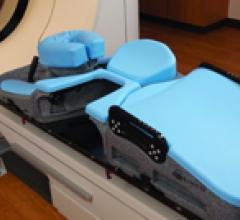
November 2, 2009 - Calypso Medical Technologies, Inc. today announced Calypso’s real-time tracking technology is included in 36 scientific presentations and posters at the 51st Annual Meeting of the American Society for Therapeutic Radiation Oncology (ASTRO), now underway at McCormick Place in Chicago.
These studies highlight the potential applications of the technology and the benefits associated with real-time tracking of the prostate, for which the Calypso System is currently commercially available.
The topics of prostate-related studies include prostate SBRT, prone prostate treatment, workflow efficiency, and dose escalation. Studies of investigational applications, such as high-velocity pancreatic and lung tumors, will also be presented. Calypso is exhibiting during this conference at booth 1231 and Calypso Systems will also be displayed in collaboration with Siemens Healthcare at booth 1829 and Varian Medical Systems at booth 2229.
Since the radiation beam is more precisely focused on the tumor target, Calypso’s technology is designed to allow clinicians to more tightly contour the radiation dose to the prostate and minimize unwanted dose to adjacent healthy tissues.
“Calypso allows us to track the position of the prostate during prolonged, high-dose SBRT treatments and provides the flexibility to stop the treatment if the prostate moves outside the intended field of radiation,” said Constantine Mantz, M.D., at 21st Century Oncology in Cape Coral, Florida. “Without Calypso, we are really just flying blind.”
In addition to prostate-related studies, data is being presented from an investigational study demonstrating the utility of the Calypso System in tracking tumor movement in the canine lung.
“The lung often undergoes dramatic movement and distortion during normal respiration, sighing, and coughing, makes targeting an extremely complicated task to handle,” said Martin Mayse, M.D., an interventional pulmonologist at Barnes Jewish Hospital in St. Louis and an investigator on the study. “With the Calypso System, we will have real-time data that tells us exactly what is going on while the patient is breathing. We will not have to make assumptions anymore.”
“The research we have conducted clearly shows that the bronchoscopic insertion of an anchored transponder is not only safe, but also does not migrate,” said Parag Parikh, M.D., assistant professor of radiation oncology and biomedical engineering at Washington University in St. Louis. “This opens up the use of electromagnetic tracking for lung tumors.”
The Calypso System will be the topic of several scientific sessions, including an independent investigation conducted at the German Cancer Research Center (Deutsches Krebsforschungszentrum, DKFZ) in Heidelberg in which researchers demonstrated real-time multi-leaf collimator tracking, as well as a study conducted at Stanford University demonstrating Calypso-guided dynamic multi-leaf collimator (DMLC) target tracking with Intensity Modulated Arc Therapy (IMAT). Dose distributions to moving targets with DMLC tracking were superior to those without tracking.
Information about the oral presentations featuring Calypso technology referenced in this news release is listed below:
• Long-term Interaction and Tissue Response of a Bronchoscopically Implanted, Anchored Electromagnetic Transponder in the Canine Lung, Mayse et al, Washington University, St. Louis
• Real-time tumor position monitoring and dynamic dose adaptation: Geometrical and dosimetric accuracy of an integrated tracking system, Oelfke et al, DKFZ, Heidelberg, Germany
• Electromagnetic-Guided DMLC Tracking Enables Motion Management for Intensity Modulated Arc Therapy, Keall et al, Stanford University, Palo Alto, Calif.
Additional Calypso-related oral presentations include:
• First Report of Real-Time Tumor Tracking in the Treatment of Pancreatic Cancer Using the Calypso System, Metz et al, University of Pennsylvania, Philadelphia, Pa.
• Patient-Reported Reduction in Acute GU and GI Side Effects for Prostate Cancer Patients Treated with 81Gy IMRT Using Reduced PTV Margins and Electromagnetic Tracking, Khan et al, 21st Century Oncology, Santa Monica, Calif.
Also highlighted as a work-in-progress will be Calypso’s Dynamic Edge Gating Technology* that will utilize Calypso’s real-time target position information to enable and disable the treatment beam in response to motion of the prostate. The treatment beam can be automatically held when the target position goes outside the motion thresholds and automatically re-enabled when the target is within the motion thresholds.
“Dynamic Edge Gating Technology is the next step in utilizing the Calypso System to facilitate precision treatment delivery approaches. By automatically enabling and disabling the beam in response to target motion, we can further enhance highly accurate treatment for organs which invariably move during treatment,” said Ed Vertaschitsch, senior vice president, operations of Calypso Medical.
Also known as GPS for the Body, Calypso’s proprietary technology utilizes miniature implanted Beacon transponders to provide precise, continuous information on the location of the tumor during external beam radiation therapy. Any movement by the patient, including internal movement of the tumor, may cause the radiation to miss its intended target and hit adjacent healthy tissue. In contrast to other tumor targeting solutions, the Calypso System provides continuous tumor position information, objectively and without ionizing radiation, thereby enabling an increase in the radiation delivered to the tumor while reducing radiation misapplied to normal tissue.
* This technology is a concept device under development and not available for sale.
For more information: www.calypsomedical.com


 March 03, 2014
March 03, 2014 





